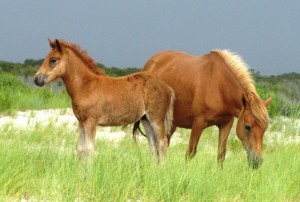
ASSATEAGUE — One wild pony on Assateague has a new name and another foal born just last spring soon will with an online auction for naming rights set for 10 days in December.
The Assateague Island Alliance this week announced N9BFQX will now be called “Bailey” after a 12-year-old Connecticut girl was chosen randomly to attach a new, less formal moniker to the chestnut mare through the AIA’s Name That Horse contest.
The mare’s current designation is taken from an alpha-numeric system put in place by the National Park Service in the mid-1970s to track the lineage and ancestry of the wild horses and identify which sub-herd they belong to and the areas they frequent on the island.
Unsuspecting Binderiya Unter was visiting the Assateague Island Visitor Center with her classmates from Ellicott City when she was selected randomly to choose a winner from over 200 entries in the AIA Name That Horse contest. Unter then chose Emma Sawch, 12, of Stamford, Conn., who, in turn named the horse formally known only as N9BFQX as Bailey, which is now the newest addition to the AIA Foster Horse program.
The next opportunity to leave a lasting legacy with the wild horses on Assateague is the AIA’s charitable eBay auction for the naming rights of the only foal born in the Maryland herd in 2013. The new foal, identified currently as N9BFQ-GL, was birthed by Harmony in a remote part of the island far from the developed north end in May and needs a common, less formal name.
Open bidding for the Name That Foal charitable naming rights auction will be held from Dec. 6-16. The highest bidder during the 10-day auction will earn naming rights for N9BQF-GL. The eBay seller is AIA2009 and the starting bid is $300. All proceeds are tax-deductible and will benefit the AIA, the friends group of the Assateague Island National Seashore.
While in some years multiple foal-naming auctions are held, the foal up for bid in December will be the only one whose naming rights will be auctioned this year. The island’s wild pony population now stands at around 115, a figure considerably lower than a decade ago, but still far from the target range of 80 to 100.
While three to five foals are added to the herd in a typical year, an in-kind number drop off due to old age, illness or other natural or man-made factors. The mortality rate is around three to five percent, meaning three to five out of 100 are lost each year to attrition, which corresponds to the three to five new foals birthed each year.
In the interest of managing the size of the herd, which, if left unchecked would overtake the barrier island and gobble up the very resources the wild ponies need to survive, the National Park Service several years ago began a contraceptive program for the mares in the herd. The mares are injected with a non-invasive contraceptive to prevent multiple births in an effort to maintain and ultimately shrink the size of the herd to its manageable threshold. In the interest of maintaining the gene pool of the famous wild ponies, believed to be descendants of domesticated horses placed on the island 300 years ago, each mare is allowed to birth one foal before being put on the contraceptive program.
